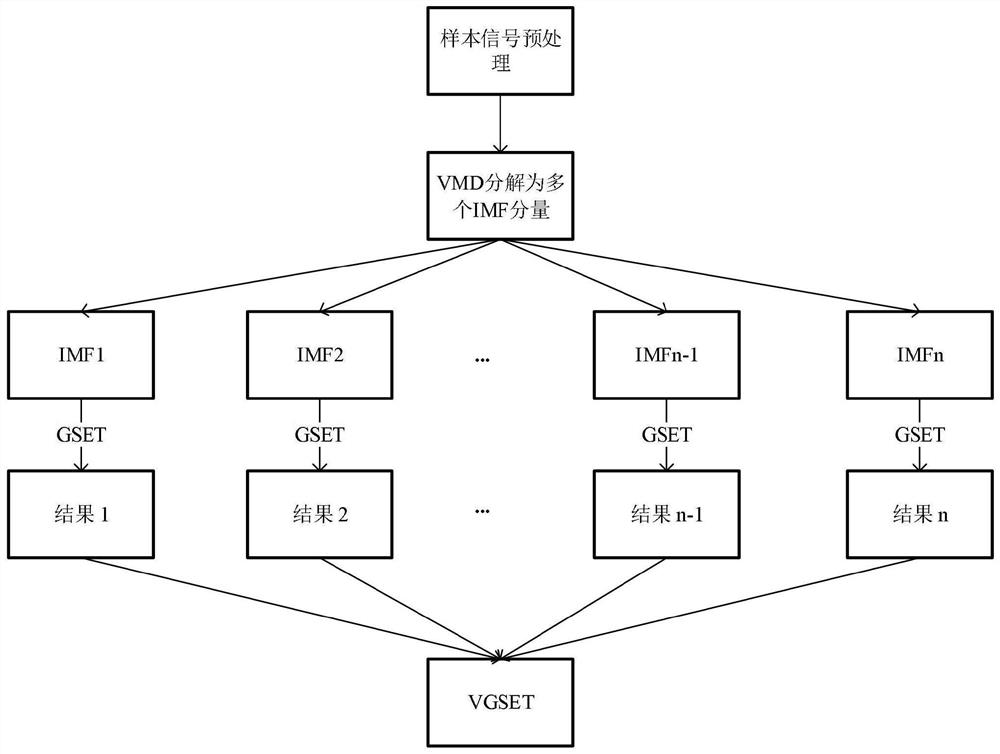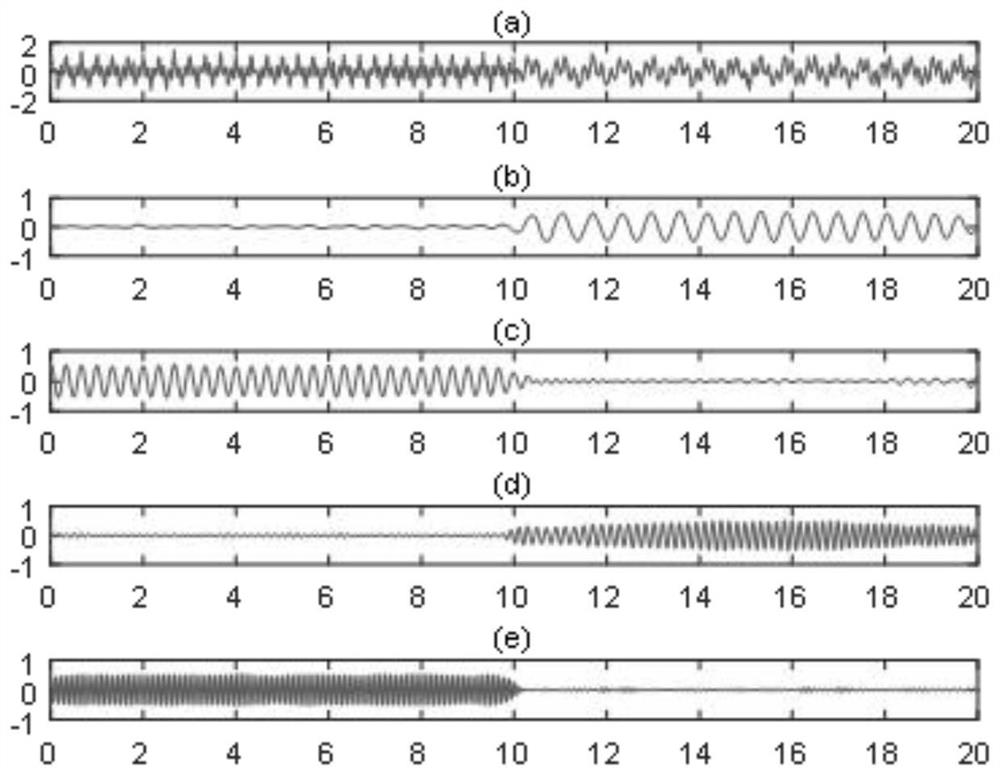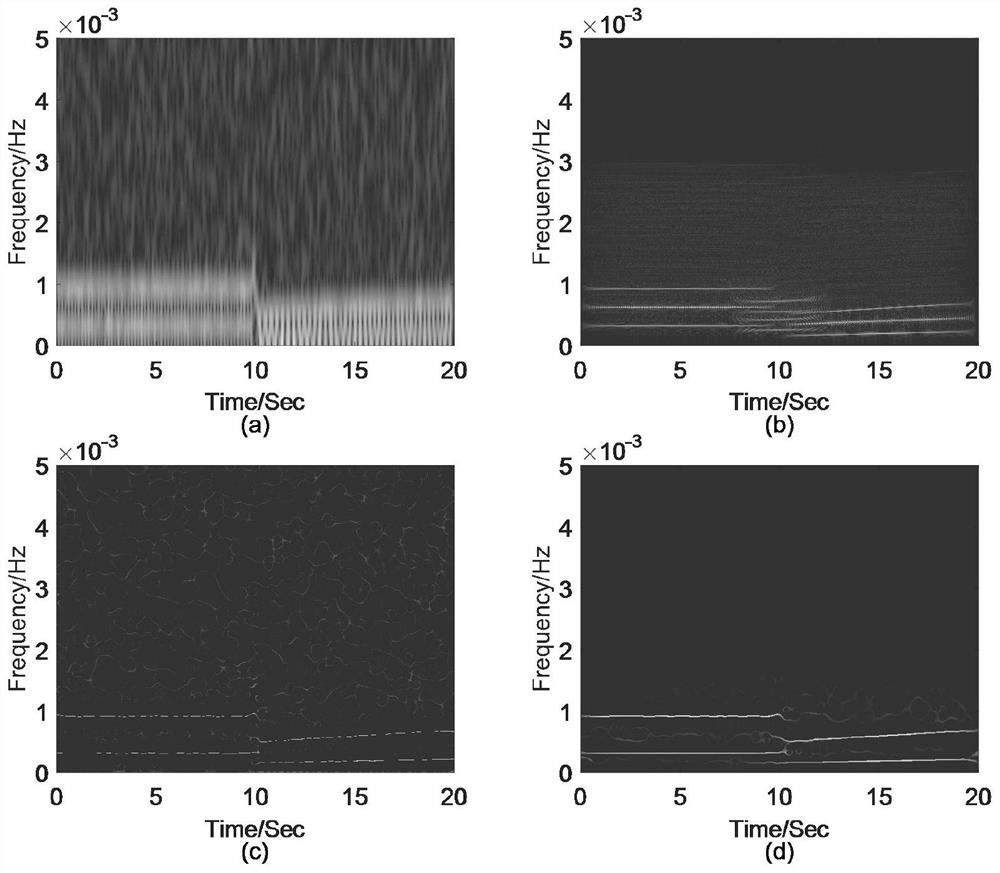VGSET time-frequency analysis method, device and equipment for bearing fault signal and storage medium
A fault signal, time-frequency analysis technology, applied in the direction of measuring devices, mechanical bearing testing, mechanical parts testing, etc., can solve the problem of not being able to obtain key characteristic information of bearing fault signals, so as to avoid modal aliasing and improve time-frequency Aggregation, the effect of improving robustness
- Summary
- Abstract
- Description
- Claims
- Application Information
AI Technical Summary
Problems solved by technology
Method used
Image
Examples
Embodiment 1
[0079] The given frequency hopping signal is:
[0080]
[0081]
[0082] f (t) = v 1 + V 2
[0083] The sampling time is set to 20s, the sampling frequency is 100 Hz, and the second penalty factor of the VMD algorithm is set to 3000, and the number of decomposition layers is set to 4. Gausson white noise is added to a signal-to-noise ratio of 16 dB.
[0084] Decomposition of frequency hopping signals to decompose multiple IMF signals, reference figure 2 , figure 2 It is the decomposition result of the VMD algorithm for the original signal (after noise), from top to bottom, the raw signal, the hopping of V1, the hopping of V1, the hopping before the hopping of V1, the hopping of V2, linear frequency modulation components , The constant frequency components of the V2 of the V2, the decomposition of the visible signal noise reduction is still considerable, and there is a clear physical meaning.
[0085] refer to image 3 , image 3 Is a time-frequency analysis result of different ...
Embodiment 2
[0091] Radar signals have an important role in people's daily lives, so the analysis of radar signals has become an indispensable research hotspot in time-frequency analysis. Commonly used radar signals include LFM, EQFM, Barker code two-phase signal, FRANK code signal, multipart-phase code signal, etc. Anti-noise performance. In this portion, the signal sampling frequency is 1000 Hz, the secondary penalty factor of the VMD algorithm is set to 1000, and the number of decomposition layers is set to 1.
[0092] refer to Figure 4 , Figure 4 (a) is a time-frequency diagram of the EQFM signal based on STFT-based SET algorithm, Figure 4 (b) is the result of the VGSET algorithm to process the EQFM signal. It can be seen from the comparison of two pictures. Figure 4 The noise component in (b) has been significantly inhibited, and Figure 4 The problem of effective component loss in (a) has also been improved, and the time-frequency aggregation of the entire map has also been significantly ...
Embodiment 3
[0095] The method is applied to mechanical bearing fault signal analysis, and parameters such as the characteristic frequency of the mechanical bearing can be obtained, and the parameters such as the related fault cause, help to solve the characteristic frequency at the time of failure of mechanical bearings, and provide a basis for the diagnosis and research of mechanical bearings. help. The VGSET algorithm can effectively analyze the complete signal characteristics of the bearing fault signal, and predict it, which has a good analysis of the bearing fault.
[0096] The mechanical bearing fault signal is complicated by a typical non-stationary signal, which contains a variety of modal signals, and it contains more noise, so it is suitable to apply this algorithm to the mechanical bearing fault signal. This algorithm has selected the data provided on the CWRU bearing center on the network. The bearing model used in the CWRU bearing center trial is SKF's 6205-2RS deep groove ball b...
PUM
 Login to View More
Login to View More Abstract
Description
Claims
Application Information
 Login to View More
Login to View More - R&D
- Intellectual Property
- Life Sciences
- Materials
- Tech Scout
- Unparalleled Data Quality
- Higher Quality Content
- 60% Fewer Hallucinations
Browse by: Latest US Patents, China's latest patents, Technical Efficacy Thesaurus, Application Domain, Technology Topic, Popular Technical Reports.
© 2025 PatSnap. All rights reserved.Legal|Privacy policy|Modern Slavery Act Transparency Statement|Sitemap|About US| Contact US: help@patsnap.com



